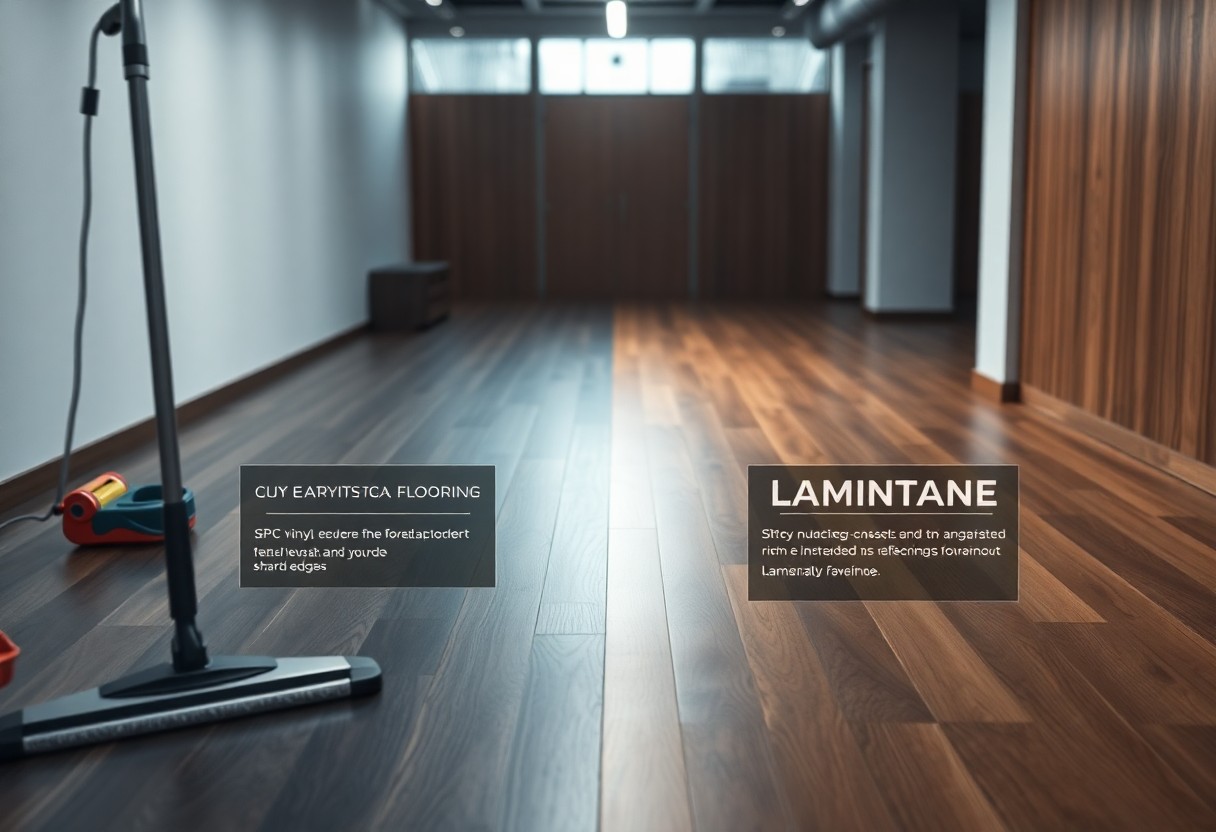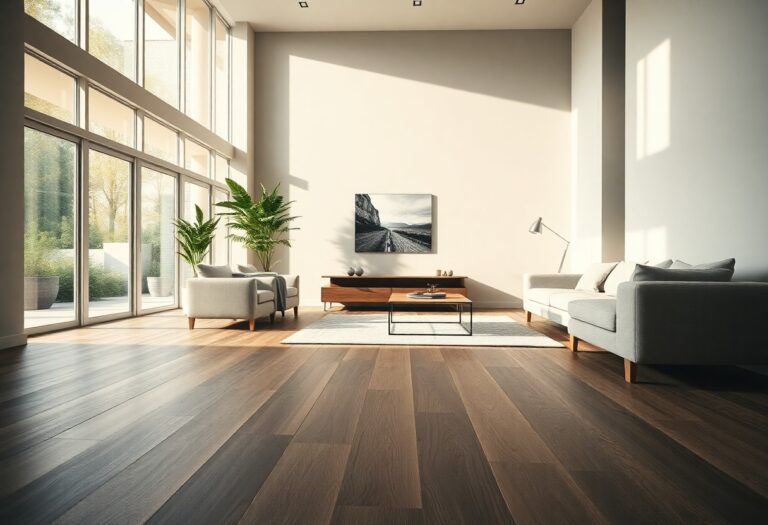Most homeowners face a tough decision when choosing flooring options, with SPC vinyl and laminate being popular contenders. Understanding the differences between these materials is key to making an informed choice that fits your lifestyle and budget. This post will research into the unique benefits and drawbacks of SPC vinyl flooring and laminate, helping you determine which option offers the best long-term investment for your home.
Understanding SPC Vinyl Flooring
SPC (Stone Plastic Composite) vinyl flooring provides a robust option for homeowners seeking durability and aesthetic appeal. This flooring type blends limestone and plastic, creating a waterproof surface ideal for various spaces, including kitchens and bathrooms. Its versatile designs mimic natural materials, giving you the look of wood or stone without the associated maintenance costs.
Composition and Structure
SPC vinyl flooring comprises several layers, starting with a rigid core made from a mix of limestone and PVC. This core is topped with high-resolution printed vinyl that replicates natural textures. A protective wear layer adds durability, while a backing layer enhances comfort and stability, making it suitable for both residential and commercial applications.
Benefits of SPC Vinyl Flooring
Opting for SPC vinyl flooring offers multiple advantages, particularly its water resistance and ease of installation. Its rigid core construction minimizes expansion and contraction, reducing the risk of warping. Additionally, these floors are easy to maintain; a simple sweep and occasional damp mop are typically all that’s required to keep them looking fresh.
With SPC vinyl flooring, you also benefit from sound insulation and enhanced stability, making it quieter underfoot compared to traditional hardwood. The range of styles and colors available allows you to customize your space without breaking the bank. Many products come with warranties of 10 to 30 years, demonstrating their durability and value as a long-term investment. This flooring option also aligns well with eco-friendly initiatives, as recycled materials are often used in production, supporting sustainable living choices. Overall, SPC vinyl flooring stands out for its blend of practicality and aesthetic versatility.
Exploring Laminate Flooring
Laminates have gained popularity for their affordability, aesthetic appeal, and versatility. They mimic the look of natural wood and stone but are engineered to withstand everyday wear and tear, making them suitable for various applications in your home. With numerous designs available, you can easily find a laminate that complements your interior decor.
Composition and Structure
Your laminate flooring consists of several layers, typically including a wear layer, design layer, core layer, and backing layer. The wear layer offers protection against scratches and stains, while the design layer features a high-resolution image of wood or stone. The core layer provides durability, and the backing layer adds stability, ensuring a reliable and resilient floor.
Advantages of Laminate Flooring
Choosing laminate flooring offers multiple advantages for your space. Its cost-effectiveness makes it appealing for budget-conscious homeowners, while the ease of installation attracts DIY enthusiasts. Laminate floors are also resistant to fading, staining, and moisture, making them easy to maintain in various environments.
Numerous homeowners appreciate how laminate flooring provides the aesthetic of hardwood without the associated cost and maintenance. For instance, designs can mimic exotic woods or distressed finishes, allowing you to achieve a high-end look. Additionally, laminate is more resistant to moisture than traditional hardwoods, making it suitable for areas like kitchens and basements. This versatility means you can enjoy beautiful floors in any part of your home without sacrificing durability or ease of care.
Durability Comparison
| Feature | SPC Vinyl Flooring |
|---|---|
| Wear Layer Thickness | 20-30 mil |
| Resistance to Scratches | High |
| Water Resistance | 100% |
| Expected Lifetime | 20-30 years |
Resistance to Wear and Tear
SPC vinyl flooring boasts superior resistance to wear and tear compared to laminate. With a thicker wear layer, it can withstand heavy foot traffic and resist scratches, making it ideal for homes with pets or children. Its durable surface means you won’t have to worry about replacing your flooring frequently.
Impact of Moisture and Humidity
SPC vinyl flooring excels in moisture-prone areas, outperforming laminate significantly. Unlike laminate, which can warp or swell when exposed to moisture, SPC’s water-resistant design allows it to thrive in environments like basements and bathrooms.
SPC vinyl flooring’s resilience against moisture stems from its rigid core construction, which remains stable in humid conditions. This makes it perfect for high humidity areas, where traditional laminate flooring may fail. You can install SPC in kitchens and bathrooms without fear of water damage, providing peace of mind and long-term value for your investment.

Installation and Maintenance
Installation Process for SPC and Laminate
For both SPC and laminate flooring, the installation process is typically straightforward, making it accessible for DIY enthusiasts. SPC can be installed over most existing floors without the need for underlayment due to its rigid core, while laminate requires a foam underlayment for added cushioning and noise reduction. You’ll find that both flooring types feature a click-lock installation method, which simplifies the fitting process and minimizes the need for glue, nails, or staples.
Maintenance Requirements
Maintenance for SPC and laminate flooring varies, but both are relatively low-maintenance options. SPC requires regular sweeping or vacuuming to remove dirt and debris, while damp mopping with a suitable cleaner ensures a clean surface. Laminate needs similar care; however, it is more susceptible to moisture damage, necessitating a cautious approach to spills.
Focusing on maintenance routines specific to your flooring will prolong its lifespan. For SPC, using a pH-neutral cleaner helps maintain its appearance without damaging the wear layer. In contrast, for laminate, avoiding excessive water is key, as it can warp the boards over time. Regularly checking for any loose planks or seams will also prevent bigger issues, ensuring that your investment retains its aesthetic and functional value for years to come.
Aesthetic Appeal
The aesthetic appeal of your flooring significantly influences your home’s overall ambiance and resale value. SPC vinyl flooring offers a wide array of authentic wood and stone visuals, enhancing the look of any space. With its realistic textures and rich colors, SPC can seamlessly blend with contemporary or traditional designs, making it an attractive option for homeowners seeking both beauty and functionality.
Design Options for SPC Vinyl
You’ll find a diverse range of designs in SPC vinyl flooring, from luxury wooden looks to contemporary concrete styles. Available in various colors and finishes, these options allow you to customize spaces to fit your personal taste and home décor effectively. The multi-layered construction also enables intricate patterns and finishes that elevate your interior design.
Design Options for Laminate
Laminate flooring provides a similar range of design options, featuring various wood species, stains, and textures. The photorealistic images on laminate surfaces replicate natural materials convincingly, and you can choose from rustic to modern finishes that suit your style. Additionally, the versatility of laminate allows for custom patterns and formats, such as wide planks or tiles, enhancing visual interest.
With laminate, the availability of different plank sizes and textures gives you the flexibility to create unique designs tailored to your space. For instance, if you prefer a farmhouse aesthetic, you may opt for wide, distressed planks in light hues, while modern settings can benefit from sleek, narrow planks in darker shades. This variety makes laminate a practical choice for achieving your desired look without straining your budget.
Cost Analysis
When evaluating flooring options, you must consider both the initial investment and long-term value to determine the best financial decision for your home.
Initial Investment
The initial cost of SPC vinyl flooring typically ranges from $2 to $5 per square foot, while laminate flooring costs between $1 to $3 per square foot. While laminate may seem cheaper upfront, factoring in the installation and potential replacement costs can significantly alter your budget. SPC vinyl often requires a little more for materials but may save you money in the long run due to its durability.
Long-term Value Considerations
Long-term value hinges on factors like maintenance, lifespan, and potential for damage. SPC vinyl flooring generally lasts 20 to 30 years, significantly outpacing laminate’s 10 to 15-year lifespan. This longevity means fewer replacements and repairs, making SPC a more viable investment for your home, especially in high-traffic areas like kitchens and living rooms.
Additionally, consider maintenance costs; SPC vinyl is easier to clean and resists moisture better, which reduces upkeep expenses over time. With laminate, the possibility of water damage could lead to costly repairs or premature replacement. If you’re planning to stay in your home long-term, opting for SPC vinyl could translate into substantial savings on both repairs and replacements, enhancing your overall return on investment.
Final Words
Drawing together the attributes of SPC vinyl flooring and laminate, you can make an informed decision based on your specific needs. SPC offers superior water resistance and durability, making it ideal for high-moisture areas, while laminate may be more suitable for budget-conscious projects. Consider your lifestyle, aesthetics, and maintenance preferences to determine which flooring type serves you best in the long run. Ultimately, investing in flooring that aligns with your priorities will yield the best results for your home.





